On 11 November 1918, the guns of the western front fell silent after four years of continous warfare. With their armies retreating and close to collapse, German leaders signed an Armistice, ending the First World War.
The eleventh hour of the eleventh day of the eleventh month attained special significance in the post-war years. The moment when hostilities ceased on the Western Front became universally associated with the remembrance of those who had died in the war.
11 ways to commemorate Remembrance Day
From discovering the history of Remembrance Day virtually to watching past National Commemorative Services, giving you the best ANZAC biscuit recipe or tips on how to interview a family member or friend about their war experiences. Here are 11 different ways that you can get ready for Remembrance Day this year.
Discover the history of Remembrance Day virtually.
View moreDiscover the history of Remembrance Day virtually.
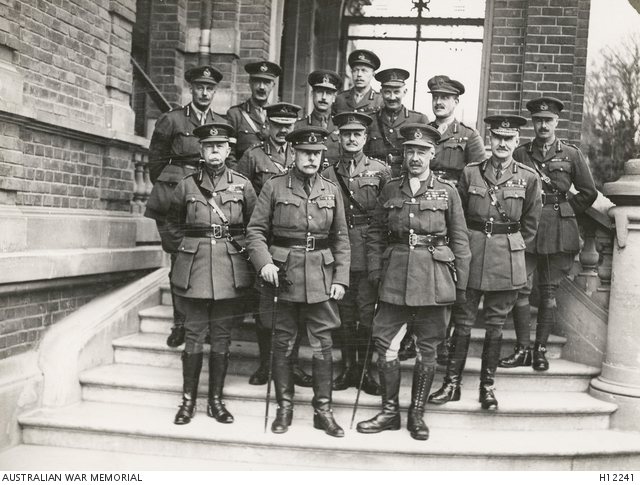
On the Australian War Memorial website, you can learn all about Remembrance Day, from ceremonial customs, watch past National Services, you can take a virtual tour of the Hall of Memory and the tomb of an unknown soldier, and even scroll through the Gallery of photographs from 11 November 1918.
Watch past national commemorative services.
View moreWatch past National Commemorative Services.
Traditionally, that Nation’s key commemoration is held at The Australian War Memorial. This includes a formal wreath-laying, the observance of a minute’s silence at 11am, participation and support on parade of Australia’s Federation Guard and the Band of the Royal Military College, Duntroon. Take a minute or two to watch past National Commemorative Services, and you can familiarise yourself with its ritual and ceremony.
Take an audio tour of the Gallipoli battlefields.
View moreTake an audio tour of the Gallipoli battlefields.
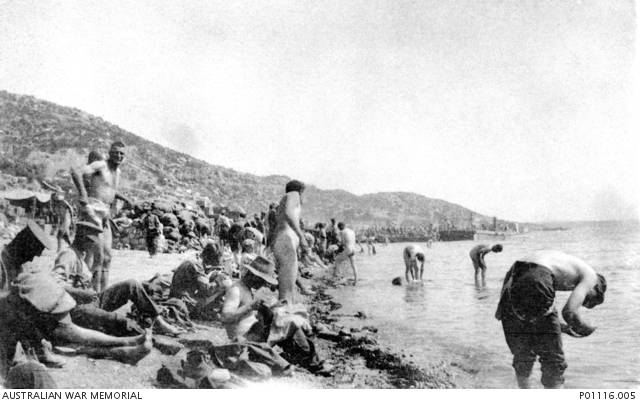
You don’t need to get on a plane to take a tour of the Gallipoli Battlefields. You can take an audio tour of the Gallipoli Battlefields instead.
#RemembranceDay #RSLLifeCare #LestWeForget
Bake
ANZAC
Biscuits.
View more
Bake ANZAC Biscuits.
During WWI, people in Australia would send parcels to our solders to show their support and help supplement their diet. These biscuits were believed to be highly nutritional and kept well while being transported overseas. ANZAC Biscuits are still popular today.
Here’s a great recipe for ANZAC Biscuits care of the The Australian Government, Department of Veterans’ Affairs.
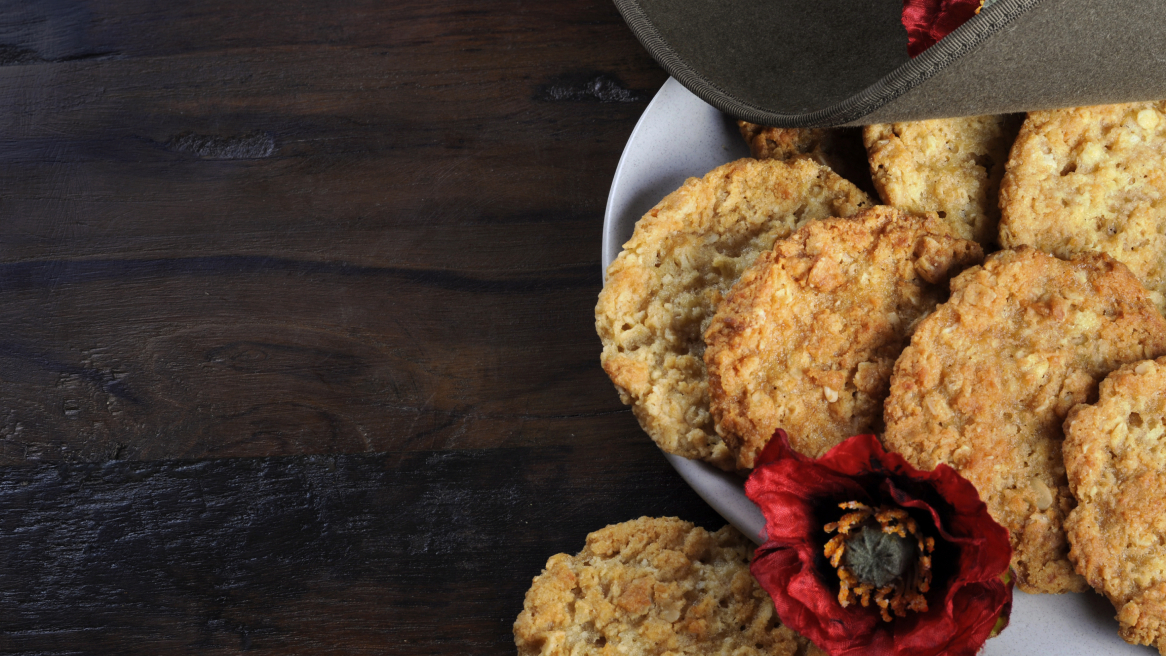
Try this ANZAC biscuit recipe at home.
Here’s a great recipe for ANZAC Biscuits care of the The Australian Government, Department of Veterans’ Affairs.
Ingredients.
2 tablespoons butter or margarine
2 tablespoons golden syrup
1 teaspoon bicarbonate of soda dissolved in 2 tablespoons boiling water
1 cup rolled oats
1 cup desiccated coconut
3/4 cup brown sugar
3/4 cup plain flour
Method.
- Heat oven to 160°C.
- Melt butter (or margarine) and syrup.
- Add dissolved bicarbonate of soda and water.
- Mix dry ingredients in a bowl, add the liquid mixture, and stir.
- Place small balls of the mixture (about 1 teaspoon) onto a greased tray.
- Bake for 20 minutes or until lightly brown.
Lift biscuits onto a cake cooling rack and wait for them to cool.
Make a
poppy out
of paper.
View more
Make a poppy out of paper.
During the First World War, red poppies were among the first plants to spring up in the devastated battlefields of northern France and Belgium. In soldiers’ folklore, the vivid red of the poppy came from the blood of their comrades soaking the ground. The sight of poppies on the battlefield at Ypres in 1915 moved Lieutenant Colonel John McCrae to write the poem In Flanders fields (see The recitation).
Making paper poppies with children is a great way to teach children about World War 1 and get creative at the same time. Watch this
Learn about
commemorative
symbols.
View more
Learn about commemorative symbols.
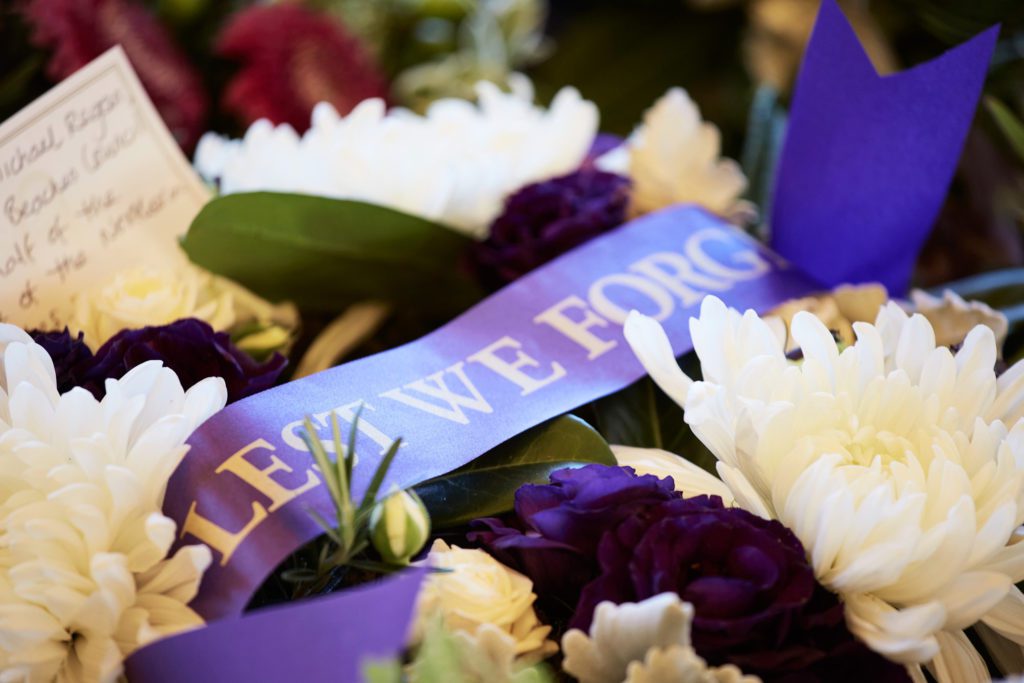
There are many meaningful symbols for Remembrance Day, from the ‘Lest we forget’ symbol, to the eternal flame, one minute’s silence, red poppies and more. The Australian Government’s Department of Veteran Affairs is a great resource of information on these symbols, their history and current practice.
Take a look at the ANZAC Portal from the Australian Department of Veterans’ Affairs and immerse yourself in learning about commemorative symbols.
Interview
someone you
know.
View more
Interview someone you know.

Do you have a family member or friend who has fought in a war? You can make their story count by interviewing them and keeping their story alive. Here are some tips for interviewing them
- Prepare a list of interview questions in advance.
This will help ensure that the interview is relaxed, runs smoothly, and that you get the most important questions answered. - Set a time to chat.
So that you have a goal to work toward and get prepared in advance. Plus, your interview can also get excited and prepared too. - Minimise interruptions.
Ensure you find a quiet space, and mobiles are turned onto silent. - Consider the interviewee.
Make sure your interviewee is completely comfortable and they are ok with the interview setting. Not everyone will be comfortable sharing their story in public. - Agree the set up before the interview.
Ensure that your interviewee knows what will happen with the interview and that you have the permission to publish/broadcast the interview. - Ready, set, interview
Give to
the Poppy
Appeal.
View more
Your donation to the Poppy Appeal will help change the lives of our veterans and their families.

Every current and former serving person of this great nation deserves our support. Your donation can help provide specialist services like housing and financial assistance, employment support, assistance with DVA claims and wellbeing programs to thousands of veterans and their families.
Listen to
Remembrance
Service music.
View more
Listen to Remembrance Service music on Spotify

Are you preparing your own Remembrance Day Service? Or would you simply like to understand the songs associated with Remembrance Day?
Here are some links to Remembrance Service music that you can easily access:
Spotify playlist
https://bit.ly/DVARemembranceDay21
The Last Post
https://anzacportal.dva.gov.au/sites/default/files/audio/the-last-post.mp3
The Rouse
https://anzacportal.dva.gov.au/sites/default/files/audio/the-rouse.mp3
Advance Australia Fair
https://anzacportal.dva.gov.au/sites/default/files/audio/advance-australia-fair-2019.mp3
Music guide for Remembrance Day
https://anzacportal.dva.gov.au/commemoration/event-planning/music
Find your
local memorial.
View more
Find your local memorial.

Local memorials have been erected across the country in recognition of our soldiers who fought in World War I. Do you know where your local memorial is? The War Memorial register allows you to look up local memorials across New South Wales.
Prepare your own Remembrance Day Ceremony.
View moreAccess our complimentary Remembrance Day program.
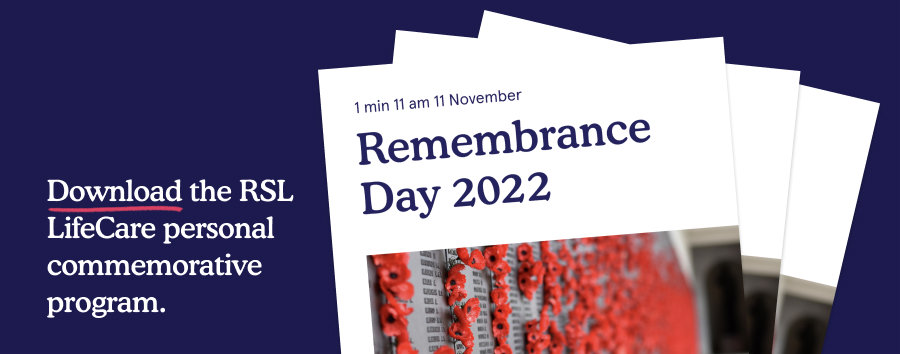
To help prepare for Remembrance Day we have put together a service program. Use this program to hold your own Remembrance Day Ceremony or to follow a service in person, online or streamed live.
The RSL LifeCare Remembrance Day Program includes an order of service, including links to audio files to download too.
Share your Remembrance Day activities with us.
Whether it’s singing along to commemorative music, making ANZAC biscuits, or paper poppies, we’d love to see how you prepare for Remembrance Day this year.
Post your activities on your Facebook page and tag us, so that we can see your Remembrance Day activities too.
More about RSL LifeCare.
Since 1911 RSL LifeCare has been serving the community by providing professional, caring support for veterans. Today, we welcome all members of the public – whether veteran or non-veteran – to live in our villages, care homes, or to support you to live independently at home.
Despite our growth and the passage of time, RSL LifeCare remains true to our original aim and mission – to provide a home of peace and security to senior Australians. Take a look at the services we offer.
Download a brochure
We'll never share your email address and you can opt out at any time, we promise






